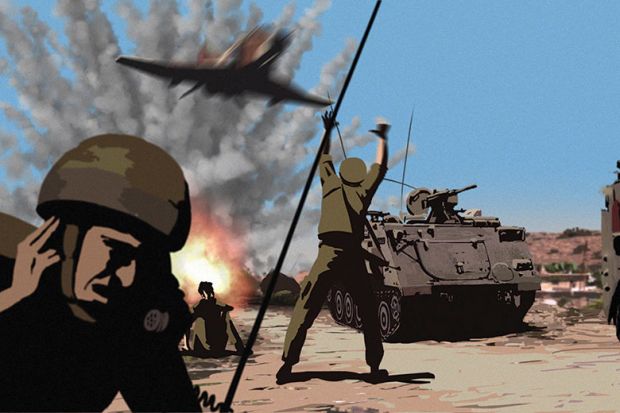Most people associate animation with stories and fiction. This might be in the form of childhood cartoon favourites such as Tom and Jerry or Scooby-Doo, or more recent films such as Beauty and the Beast and Frozen. Even more niche examples of animation, for instance, Japanese manga films – Howl’s Moving Castle, Spirited Away, Princess Mononoke – are known for their fantastical storylines. No doubt, animation is traditionally associated with fiction because it is a medium that is perfectly suited to the imagination: whereas a drawing is fixed in space and time, the animator can literally bring an idea to life.
Donna Kornhaber’s Nightmares in the Dream Sanctuary turns this association on its head and argues that the “boundless, amaranthine plasticity” of animation allows us to experience the disruptive and traumatic quality of war, and to bear witness to episodes or even emotions that have been silenced or repressed. The 40 or so animated war films that she focuses on are all based on factual events and span a staggering breadth of global conflicts ranging from guerrilla warfare in Uruguay during the 1970s to the 1993 Burundian civil war to recent events in Israel and Palestine. Some of the films have been created by artists who lived through the events depicted; others are works of imagination that recreate historical events not actually witnessed by the animator – for example, the melting of charred flesh caused by the Hiroshima bomb in Renzo and Sayoko Kinoshita’s Pica-don (1979). Each film, argues Kornhaber, constitutes an act of witness, a means to ensure that the atrocities of the past are not forgotten.
Although it may seem problematic to reduce such a broad range of historical, national and political contexts to a single thesis, Kornhaber’s arguments are interesting and articulated in a lively and engaging style that deftly interweaves personal responses to the films with meditations on cultural and literary theory. A pertinent example of this is the first chapter, titled “Resistance”. Here, Kornhaber cites the German Jewish philosopher Walter Benjamin to distinguish between allegory, which “requires copious acts of interpretation”, and symbol, which should be clear “to the point of transparency”. In works of resistance animation in repressive societies, the artist must create a film that is both symbolic and allegorical: that is, as clear as crystal to the oppressed, yet unfixed and open to interpretation to the oppressor. In this way, the film will pass the censors yet still impart a message of resistance to those who need it. Kornhaber’s detailed discussion of this double function is one of the most enjoyable sections of her study.
Nightmares in the Dream Sanctuary demonstrates tremendous knowledge, and it is truly surprising to discover just how many animated war films there are, given that only a handful, such as Waltz with Bashir and Persepolis, are internationally known. However, the sheer number of case studies is exhausting and frustrating because it is impossible to really get to grips with all the political contexts described. Kornhaber’s objective to rationalise the entire history of animated war film is ambitious, but even if she had analysed only a fraction of the films, her conclusion would have been just as effective.
Giulia Miller is a visiting lecturer in literature at the University of Chester and the author of Studying Waltz with Bashir (2017).
Nightmares in the Dream Sanctuary: War and the Animated Film
By Donna Kornhaber
University of Chicago Press, 304pp, £27.00
ISBN 9780226472683
Published 28 January 2020
Register to continue
Why register?
- Registration is free and only takes a moment
- Once registered, you can read 3 articles a month
- Sign up for our newsletter
Subscribe
Or subscribe for unlimited access to:
- Unlimited access to news, views, insights & reviews
- Digital editions
- Digital access to THE’s university and college rankings analysis
Already registered or a current subscriber? Login







